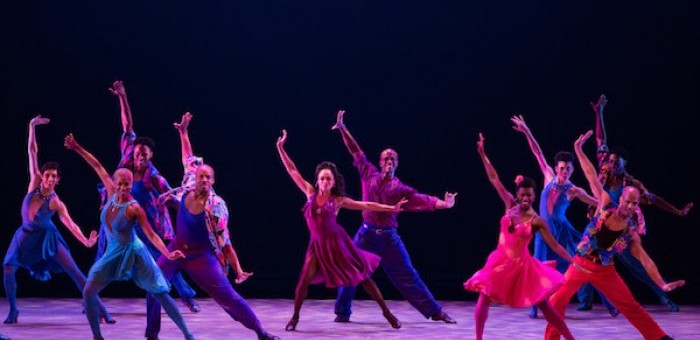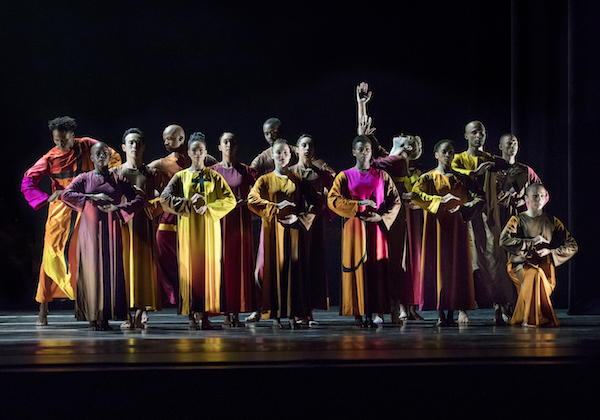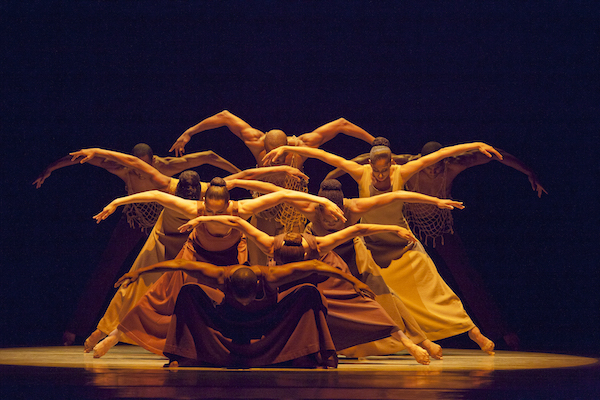Oct 28, 2025 10:47 AM
In Memoriam: Jack DeJohnette, 1942–2025
Jack DeJohnette, a bold and resourceful drummer and NEA Jazz Master who forged a unique vocabulary on the kit over his…

The Alvin Ailey American Dance Theater performs Billy Wilson’s Winter In Lisbon.
(Photo: Teresa Wood)The Alvin Ailey American Dance Theater made its premiere in 1958, when the company’s 27-year-old namesake director swept into New York’s 92nd Street Y and almost instantaneously changed the direction of American dance. The piece that launched his career—transforming the dance troupe from an ensemble that toured the country in a station wagon to an internationally recognized artistic incubator—was “The Blues Suite,” a choreographed interpretation of traditional African-American folk songs that challenged the notion of typical ballet fare and made a priority of examining the black experience through balletic forms.
Since its inception, the company has maintained a steadfast dedication to staging African-American music. On June 14 at the David H. Koch Theater at New York’s Lincoln Center, the company, under the guidance of artistic director Robert Battle, turned its interpretive eye toward Ella Fitzgerald and Dizzy Gillespie, two musicians who have been the subjects of many tributes in 2017, their centenary year. These two jazz-oriented dance pieces were included in a four-part program that also featured the New York premiere of Mass—a new work with music by John Mackey, costumes by Fritz Masten and choreography by Battle—and the return of Ailey’s most iconic ballet, Revelations.
The troupe displayed its familiarity with the jazz idiom during the opening number, choreographer Billy Wilson’s The Winter In Lisbon, which drew upon music from a soundtrack Gillespie recorded for a 1991 Spanish film of the same name. As the curtain lifted, dancers appeared in costumes of cool violet and luminescent fuschia for the slow, noirish “Opening Theme,” which was written for the movie by Gillespie with his longtime manager, Charles Fishman. On stage, the dancers twisted and coiled through columns of blue light and foggy shadows, maintaining elegant curves and beautiful arcs throughout. A slow, sinewy tempo undergirded the dancer’s motions, which were entirely fluid, almost frictionless.
The next number, “San Sebastian,” began with a solo by a male dancer, the choreography a reflection of the muted trumpet solo that constitutes the song’s main theme. Dressed in an unbuttoned Hawaiian shirt, suspenders and short-brimmed fedora, the dancer turned the precise stabs and swoops of Gillespie’s improvised lines into keen physical motions, incorporating elements of jazz, classical and modern dance into his kinetic translation.
A male and female dancer enacted an episode of longing and halting romance during the ballad “Lisbon,” which was written by Gillespie and arranged by Slide Hampton. Elegant lifts commingled with turns and statuesque poses before the scene ended with the two dancers on the verge of a kiss, their impassioned fling evaporating with the fog that lifted from the stage floor.
The entire ensemble joined in for the first movement’s final number, “Mantenca,” which featured audio from Gillespie’s 1957 energized live version at the Newport Jazz Festival. Forms and structures from salsa and mambo dancing served as choreographic touchstones, as the company, through graceful leaps and lifts, brought striking, sensuous athleticism to the stage. As the music came to a close, a portrait of Gillespie descended from the rafters, the trumpeter’s right-angled horn shown cradled in his arms.

Robert Battle’s Mass (Photo: Paul Kolnik)
After a brief intermission, a group of dancers returned in floor-length church robes for the company premiere of Mass, the latest work by computer-music innovator Mackey. (The composer, who was born in 1975, became an accomplished composer of music for ballet, but never formally studied an instrument.) Performed by a percussion ensemble consisting of marimba and drum set, the music was trance-like in its repetition, but over time developed strains of menacing darkness and foreboding. Dancers careened about the stage on their toes, creating the illusion of hovering, and the ensuing choreography was an amalgam of glitchy hand gestures, ecstatic full-body bends and spontaneous prostrations, an intense and writhing combination that captured the rapture of a religious experience.
Musical conduits between the church and jazz were established with the following piece, Ella, which was essentially a dance interpretation of Fitzgerald’s 1957 live recording of “Air Mail Special,” as it appears on her Live In Paris album. Two male dancers, suited up in faux tuxedos, tapped and pantomimed to the uptempo swing piece, in which Fitzgerald made a pastiche of lyrics from “The Christmas Song” “And The Angels Sing” and “The Davy Crockett Theme Song.” With unflagging energy, exactitude and wit, they held forth in a dialog made of agile leaps and nimble soft-shoe that brought to life the boundless enthusiasm of the First Lady of Song.

Alvin Ailey’s Revelations (Photo: Gert Krautbauer)
The evening closed with the performance of Revelations, Ailey’s most recognizable number, first performed in 1960, which found the ensemble re-examining traditional hymns such as “Wade In The Water,” “Fix Me, Jesus” “Sinner Man” and “Rocka My Soul In The Bosom Of Abraham” in the contexts of personal freedom and jubilation, as well as collective pain and suffering. Soloist Clifton Brown was radiant during his interpretation of “I Wanna Be Ready,” emanating graceful muscularity as he depicted, while prostrate onstage, the agonized forms of a spiritual man on the verge of death. His body served as an arresting visual, keying in on program’s vital themes of deliverance and hope. But as a physical symbol, it had company. One other prominent pose—of the dancers bent forward, their heads lowered, arms bowed like the wings of a bird—was a powerful motif, and imparted the feeling of ascendance toward some greater good. DB

Jack DeJohnette boasted a musical resume that was as long as it was fearsome.
Oct 28, 2025 10:47 AM
Jack DeJohnette, a bold and resourceful drummer and NEA Jazz Master who forged a unique vocabulary on the kit over his…

D’Angelo achieved commercial and critical success experimenting with a fusion of jazz, funk, soul, R&B and hip-hop.
Oct 14, 2025 1:47 PM
D’Angelo, a Grammy-winning R&B and neo-soul singer, guitarist and pianist who exerted a profound influence on 21st…

Kandace Springs channeled Shirley Horn’s deliberate phrasing and sublime self-accompaniment during her set at this year’s Pittsburgh International Jazz Festival.
Sep 30, 2025 12:28 PM
Janis Burley, the Pittsburgh International Jazz Festival’s founder and artistic director, did not, as might be…

Jim McNeely’s singular body of work had a profound and lasting influence on many of today’s top jazz composers in the U.S. and in Europe.
Oct 7, 2025 3:40 PM
Pianist Jim McNeely, one of the most distinguished large ensemble jazz composers of his generation, died Sept. 26 at…

Drummond was cherished by generations of mainstream jazz listeners and bandleaders for his authoritative tonal presence, a defining quality of his style most apparent when he played his instrument unamplified.
Nov 4, 2025 11:39 AM
Ray Drummond, a first-call bassist who appeared on hundreds of albums as a sideman for some of the top names in jazz…